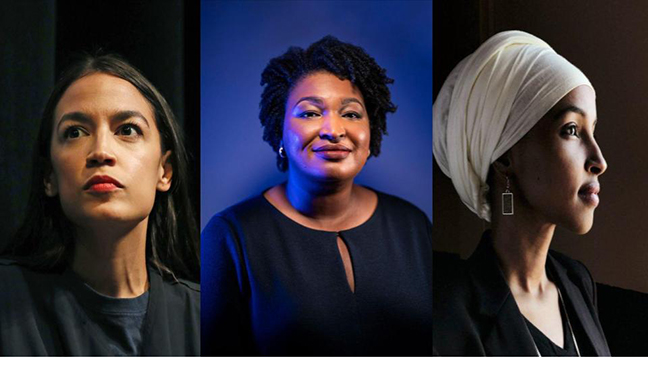2020…trash but still ironic
The irony of 2020 also being synonymous with perfect vision is hard to miss, as last year was definitely illuminating – racial injustice, health care disparities, government unpreparedness, and the loss of several cultural icons. Then there was the presidential election, centered amidst an ongoing pandemic. The election spilled into 2021 as Georgia Senate runoffs took place between Reverend Warnock (D) and incumbent Loeffler (R), as well as incumbent Senator Perdue (R) and Ossoff (D). Moving further into 2021, what lessons can be learned from last year? Here are some interesting takes from the 2020 presidential election exit polls.
A young voter does not mean a liberal voter
When it comes to voting and age, the narrative has typically been that younger voters tend to be more liberal than conservative. However, 2020’s exit polls tell a different story. The idea that younger voters are more liberal is only true for mainly young Democrats of color, especially Black and Latino voters. The majority of young white voters between the ages of 18 and 29 voted for the Republican ticket, by 53 percent. The youth vote is sort of a misnomer, it appears ‘youth unity’ ends with politics, or when the Drake song stops playing.
Conversely, young Black voters between the ages of 18 and 29 voted most similarly to the oldest Black demographics in the country, 65 and older. Both younger and older Black voters voted about 90 percent and more for the Democratic ticket. One theory for why young voters of color voted so similarly to their baby boomer counterparts, is a similar civil rights climate of their respective generations.
Black millennials have money on their minds
By comparison, Black millennials (born 1981-1996) and younger Black Gen Xers (born 1965 -1980) were actually the least reliable Black generational cohorts for Democrats, Black millennials especially. Democrats won 77 percent of Black millennials and 82 percent of Black Gen X votes. Some reasons for why Trump was able to garner sizable votes from young voters of color could be his economic promises and his wealth centered rhetoric, as millennials and Gen X are still in their prime earning years.
Also, both groups have experienced more economic hardships than baby boomers. Additionally, millennials are the media generation and are largely influenced by social media. Donald Trump’s celebrity and social media dominance may influence the ideologies of some millenials more easily than other generations.
Men of color
Despite the heightened racial tensions and push for civil rights, the Trump ticket was able to win a significant chunk of Black and Latino male votes. About one in every five Black men voted for Donald Trump, mostly Black men between their late 20s and early 40s. Similarly, Latino men gave 36 percent of their votes to the Republican ticket. Trump’s irreverent machismo and wealthy image could be additional reasons for MAGA support among a significant minority of Black and Latino male voters. If this trend continues, the Democratic party may have a problem winning the 2024 election.
Let’s talk about sex
According to 2020 exit polls, women of color tend to vote more than their male counterparts. Black women and Latinas make up double the percentage of Black and Latino male voters, respectively. However, polls suggest that white women make up the minority half of white voters–– 48 percent white women to 52 percent white men.
Black women delivered a whopping 91 percent of their votes to Biden, compared to 79 percent of Black men, while Latinas voted for Biden by a majority 70 percent. In comparison to 2016, Donald Trump increased his support among white women, jumping from 52 percent to 55 percent. Among white men, the Republican party held onto its lion share of male voters, with 61 percent of the white male vote.
Latinos are not a monolith
While the majority of Latinos vote for the Democratic party, the Latino ethnic category is an incredibly diverse voting group, with very divergent voting interests. Puerto Rican Americans for instance, the second-largest Hispanic group in America, vote more democratically than Cubans. To add, many Latino ethnic groups don’t have the same stake in the ‘build the wall’ campaign, which mainly targets the largest Hispanic/Latino ethnic group in the U.S, Mexicans. Some critics of Biden’s Latino outreach suggest doing more targeted campaigning to specific Spanish speaking groups, and not only campaigning to Latinos (mainly Hispanic Americans) as a whole.
White America divided
Arguably, no group is as divided on their political affiliations as white Americans. White Americans are almost evenly split in their support for either the Democratic or Republican party. As a voting block, they are the least reliable for Democrats and the most reliable for Republicans, especially white men between the ages of 30 and 60 plus. Interestingly, poll results suggest that white Americans are making up less of the youth population in America. One reason could be that white Americans over the last few decades have had fewer children than people of color.
The future is Black, female, and Latina
Republicans do seem to be gaining traction with aspirational wealth and anti-government rhetoric, with voters of color. It seems racial inequality is a slightly more important issue among the youngest and oldest voters of color, Gen Z and baby boomers. However, women of color, who make up a majority of the voting youth population, are resistant to conservative and Republican views. The future is looking increasingly young, brown, and female.
Roderick Thomas is an NYC based writer, filmmaker, and Host of Hippie By Accident Podcast.











2 Comments
Love your views and makes an eye opener , thank you for the food for thought
Interesting lesson on who’s voting. Loved the facts and article lends a great view and surprising facts.